|
Software - Download
Software - Presentation
Technical Articles
Assemble Guides
Product Manuals
|
|
|
 |
|
|
The traditional passive approach |
|
For a long time the traditional method of designing a hi-fi system has been: From source (CD DVD TUNER TURNTABLE)
to preamplifier / surround processor and into a power-amplifier. From this equipment the high-level signal is fed to the
loudspeakers. Inside the speaker the high-level signal is split in frequency bands and then fed to the tweeter and woofer.
The circuit that handles this splitting is the crossover, and it consists of a number of coils, capacitors and resistors
that separate out the different bands to suit the requirements of the different drivers. To process at high-level signals
require components to be chosen primarily for their power-handling capability and not for their audio quality.
These components are often far from perfect and will introduce distortion. At high power levels everything is more
difficult to manage and cables that are connected between amplifier and speaker-cabinet can impact the sound of the system
- the only one that benefits here is those who make expensive cables. Even if air-cored inductors and film capacitors
are used, it is still difficult to design a crossover without making compromises in the frequency characteristics or
making unpleasant loads to the power amplifier in terms of impedance or phase angle. Further more the relative efficiencies
of the drivers have to be matched by adding resistors - wasting power and damping - this could limit the choice of drivers.
In a passive system, power and control will be lost - since it is the signal that drives the crossover components.
Many factory-made speakers have the possibility of separate external cables for each driver in the speaker illustrated below:
|
|
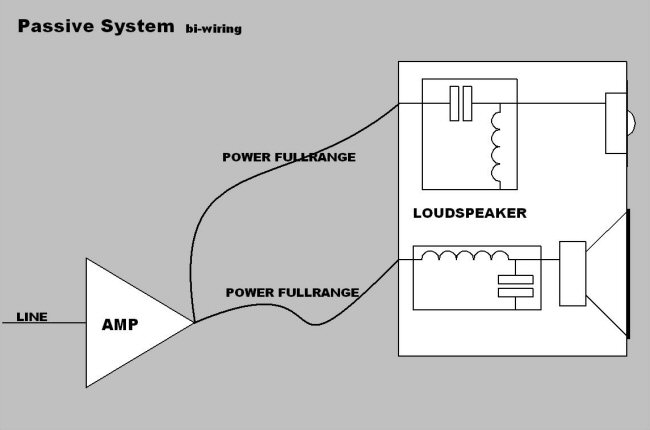 |
|
|
It could even have separate amps for the separate lines of crossover and driver: |
|
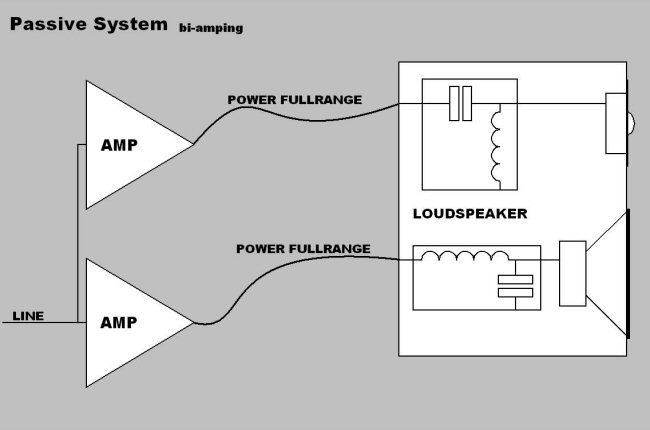 |
|
But what are the gains? - Next to nothing! - The amps will still have to operate at full bandwidth through the passive crossover.
- No, there are some who gain from this, the makers of expensive cables and amplifiers! |
|
|
The active solution: |
|
It is sometimes worth looking in another direction to find solutions - in this case toward the professional world. To make
high sound pressure levels - (not that it is what we are looking for) they are forced to have high efficiency within the
speakers. Highly efficient compression drivers/horns (about 110dB/1m) and less efficient woofers (98-104dB/1m depending on
enclosure/bandwidth) - it is not possible to do without active amplification to make a sensible system - there is too much lost when
attenuating the level of driver/horn to the level of woofer combined with the ineffective deriving of multiple bands in a
passive crossover. For decades they have operated the crossover at line level which is in front of the amps. In professional
live sound, it is common to have the active, digital, electronic crossover in combination with several amps to drive the speakers.
This method delivers a number of important benefits:
1. Crossover is operating at line level, so with regard to components the highest quality can be employed, such as metal-film
resistors, plastic capacitors and high performance integrated circuits.
2. An active crossover design has the possibility of independent adjustment of phase and amplitude, complex filter curves -
without any worrying about driver efficiencies and impedances of driver-units.
3. When the amplifiers are connected directly to the drivers - the amplifier is in control of the entire speaker-range.
This results in high damping factor. Simplified the amplifier controls the speaker cone to give no room for other movement other
than supposed to - as a result resonant frequencies will be restrained by the amplifier. (The electrical energy generated by the
resonant movement is fed back to the amp, which will damp the incorrect motion of the cone). This is important, because a
tweeter's resonant frequency often is outside the frequency band supplied to it. In an active system, the amp can deal with
this, but in a passive system, it can't. This tight control also allows the system to sound excellent at any level, from a
whisper to a loud thunder.
|
|
 |
|
Power considerations:
The active approach will require a power amplifier per crossover band, rather than just one.
This is more costly, but the truth is that the active loudspeaker is much more efficient. When a single amplifier is used in
a passive system, it has to produce extra power to operate the drivers in the system. Power will be wasted producing heat in
the crossover. Strange impedances at certain frequencies and a wide range of loads will demand power. There also has to be
allowances in power for all manner of extraordinary unknowns. The amplifier and the power supply should have the ability to
handle the strange loads likely to be encountered in use and abuse. The common method of dealing with these possibilities is
to over-engineer the power amplifier. But in an active system, the power that is produced will be fed into a defined load
and bandwidth. This is obviously much more efficient and could actually be less expensive. Example: Listening to a piece of
music that includes both bass and treble, which require a level of 20V peak to peak at both woofer and tweeter. In the passive
system (disregarding the losses of the crossover) the amplifier needs to develop a 40V peak to peak signal. (8 ohms equal 100W)
In the equivalent active system a pair of 25W amps will do the same job! And we won't think of a three way passive system with
same conditions - 225W!!!
|
|
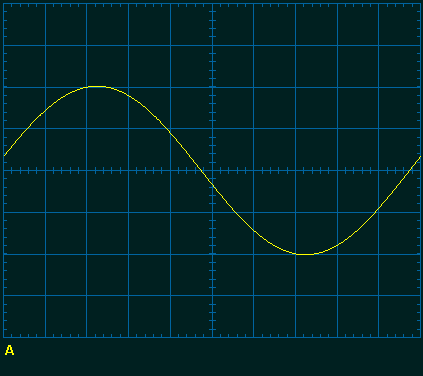 |
Bass signal:
The output of the bass amplifier at 100Hz in the active system. |
|
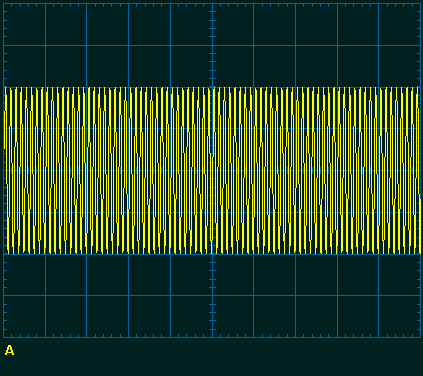 |
Tweeter signal:
The output of the tweeter amplifier at 8kHz in the active system. |
|
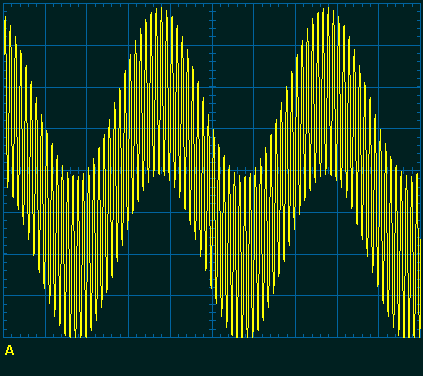 |
Bass + Tweeter signal:
This is the total requiments of the amplifier, if the loudspeaker has a passive crossover. |
|
Digital signal processing:
When a conversion from passive to active takes place, the impossible becomes possible. Especially when the electronic filter
is digital. The power of processing in the digital domain gives nearly unlimited ways to manipulate the response of the speaker.
That is without any cost because no noise and distortion is added. The only cost is conversion in the A/D & D/A converters, by
using high performance converters, this will be a smaller problem. The processing gives numerous functions: high/low pass
filtering, perfect matching gain, phase delay, notch filters, bass & treble boost/cut, parametric equalization, high/low-pass
shelving filters and power limiting. This adds up to perform deeper bass from a smaller cabinet, natural dynamics, greater
versatility in crossover design, correction of driver response, cabinet response/resonances and room resonances, easy and at no
cost; the ability to experiment with future upgrades of enclosure/drivers/settings/placing of cabinets by PC.
|
|
 |
Analogue or Digital Active Crossover
Why use AD converter, DA converters, DSP, µC, opto-couplers, oscillator etc. when an active crossover filter can be designed
with only OP-AMP? Itís obvious because much more can be accomplished in terms of processing, less space, less noise and
distortion, more flexibility, more precision, less time consume and ease of setup with the powerful software tool, XOverWizard.
|
|
Quotes from those who have converted:
Don't be afraid of digital solutions, hear it before you make any judgements on them. The benefits of digital signal processing
are much much bigger than the extra electronics and converters which come along. Highs are smooth and sweet. Music sounds balanced
and articulate, with clarity and detail retained. Subtle body movements of the musicians clearly audible.
Going from passive crossovers to sophisticated digital crossover activated speaker setup:
The bass is tighter and the highs more brilliant.
The correction of delay. WOW!! The stage opens widely. You will hear each instrument exactly at the position it belongs to.
All sounds so open and transparent. The system will really cry for more volume and you will never get the impression that it is
too much. The sound stays open and clear and you will never get tired of high volumes.
|
|
|
|
 active@groundsound.com
active@groundsound.com
 active@groundsound.com
active@groundsound.com